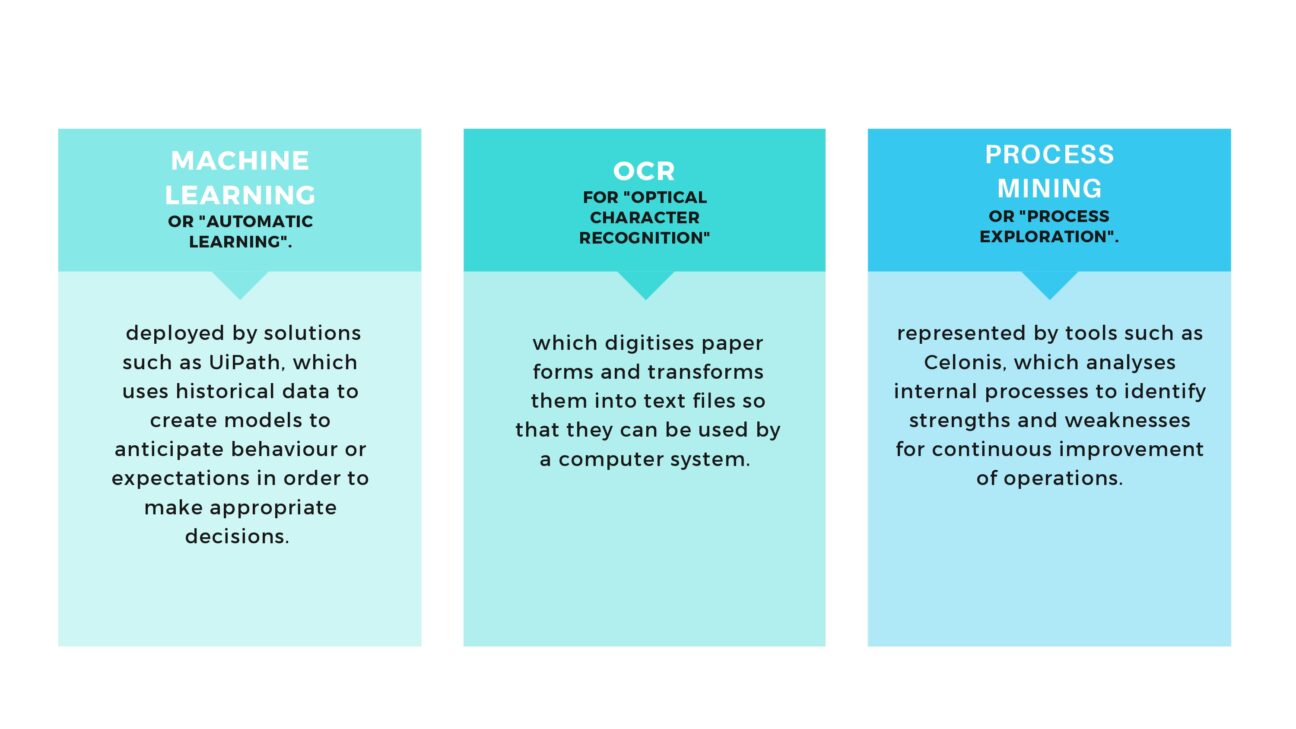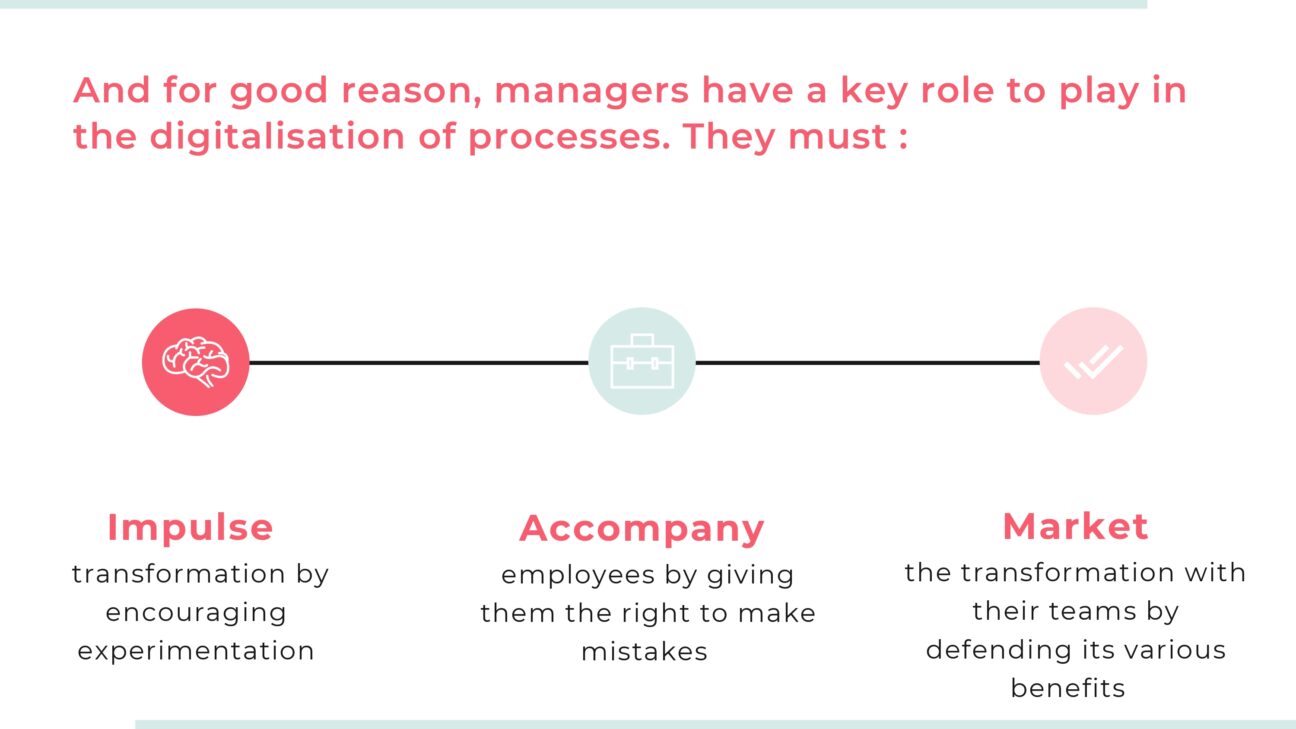
Digital process transformation is a must. It facilitates the development of digital products while improving the experience of customers and employees. So, what exactly are the opportunities associated with this change and what tools should be used to successfully carry out the Digital Process Transformation?
The Potential Benefits of the Digital Process Transformation of companies
Digital Process Transformation brings three main benefits to companies that implement it:
- A more efficient company
- More satisfied customers
- More fulfilled, committed and loyal employees
A more efficient company
First off, Digital Process Transformation facilitates innovation. It hides the complexity of processes and makes internal and external communication more fluid, thus increasing operational efficiency.
Digital Process Transformation also contributes to the company’s performance and growth since, with the same equipment, it allows production to be increased or made more advanced.
Finally, Digital Process Transformation reduces operational risk, for example, by avoiding duplicate entries and limiting the exchange of e-mails.
More satisfied customers
The digitalisation of processes also aims to improve the service provided to customers. It facilitates the sharing of data between the various departments, the use of feedback or customer expectations, and therefore a better understanding of customers.
The result is a service that is better adapted to demand, an optimised customer experience and, ultimately, long-lasting customers.
More fulfilled, committed and loyal employees
Finally, the company’s Digital Process Transformation meets the objectives of attracting, retaining and engaging employees. It facilitates the daily use of employees, especially when teams work in hybrid mode. As true business partners, employees can now concentrate on high-value-adding, meaningful and rewarding tasks.
The icing on the cake is that digitisation makes it possible to offer jobs that are more in line with the aspirations of generations Y and Z, who have both grown up with digital technology.
Digital Process Transformation is therefore a competitive advantage in recruitment, particularly in the context of the “War for Talent” and the “Great Resignation.” As we can see, the impact of Process Transformation on the company is therefore particularly positive in multiple aspects.
So, what are the levers that we can pull for Digital transformation and how can it be implemented?
Tools for the Digital Process Transformation of Organisations
From a technological point of view, Digital Process Transformation is based on two dominant solutions: enterprise platforming and artificial intelligence (AI). There’s also a rising trend in the use of low-code and no-code platforms in Digital Process transformation as a compliment.
The technological platforming of the enterprise
Technological platforming is the sine qua non of an ambitious Digital Transformation, i.e. one that is carried out at the scale of the organisation.
Technology platforms such as ServiceNow can simplify existing business processes, eliminate non-value-added tasks and free up time to optimise value-generating tasks.
These solutions articulate the business applications already used by the company and thus facilitate interactions between the different actors of the same value chain.
With these platforms, it is possible to orchestrate and streamline end-to-end processes to simplify the daily work of employees and optimise the customer experience.
In the context of a Digital Banking Transformation project, this technology could, for example, be used to coordinate all stages of a loan application. From the instruction in the branch or on the application to the credit application in the back office, including all credit risk and compliance checks, all stages of the process will be harmonised.
In doing so, process automation will improve the employee experience and make this often complex process more transparent for customers.
Artificial Intelligence (AI)
Artificial Intelligence (AI) is also an essential tool for the digital transformation of organisations. The latter can be based on three main types of AI:
- Machine Learning, which is deployed by solutions such as UiPath, exploits historical data to create models to anticipate behaviours or expectations in order to make appropriate business decisions.
- OCR (optical character recognition), which digitises paper forms and transforms them into text files so that they can be used by a computer system, without manual action.
- Process mining, represented by tools such as Celonis, featured on TechRadar by Devoteam, which analyses internal processes to identify strengths and weaknesses for continuous improvement of operations.

Low-code/no-code
Finally, no-code and low-code tools can also be mobilised as part of the Digital Transformation of companies.
Thanks to low-code or no-code platforms, such as PowerPlatform or OutSystems, new developers, the ‘Citizen Dev,’ are able to create new applications without necessarily having advanced IT skills, for example by assembling different pre-coded components.
As you will have understood, technology is essential to the success of Digital Transformation. However, it is not the only lever that can be activated in order to achieve a successful Digital Transformation…
How to (really) succeed in your Digital Process Transformation
To be successful, Digital Process Transformation must be ambitious and pragmatic and place employees and customers at the heart of the change. From this perspective, several actions must be considered:
Transforming an initial process from A to Z
Although intimidating, Digital Process Transformation should not scare decision-makers. It is simply important to be pragmatic in its implementation.
In concrete terms, the first step is to carry out a pilot Digital Process Transformation project from start to finish. This “test” project must aim to transform a specific process from A to Z. The choice of the test process must be made with care. A multi-actor process, such as the employee onboarding process, will be very suitable.
In this example, it will be a matter of orchestrating tasks that fall under the responsibility of different departments: the creation of an email address by IT, the signing of the contract by HR, the creation of the badge by security, etc. All these steps will be grouped together in a computerised workflow to facilitate management, provide greater visibility and ultimately improve the reception of new arrivals.
Measuring the benefits of the Transformation for employees and customers
Starting from the first pilot of the Digital Process Transformation project, an employee-centric approach should then be adopted. As a decision-maker, it is necessary to ensure that the Process Transformation is carried out for and with employees.
To do this, you need to measure the success of the Digital Process Transformation in terms of the benefits it brings to employees.
The key is to evaluate the Digital Transformation using KPIs that measure the value brought to the teams and the degree of satisfaction of the latter. Indicators such as time to complete a process or Employee Net Promoter Score (eNPS) can be used.
Similarly, metrics can be put in place to assess the impact of Process Transformation on end customers.
Implementing new management styles
Finally, to ensure the success of the Digital Process Transformation, it is essential to fully involve managers and convince them of its benefits.
Managers have a key role to play in the digitalisation of processes. They must in fact:
- drive the transformation by encouraging experimentation,
- support employees by giving them the right to make mistakes,
- and market the Transformation to their teams by defending its various benefits.
To facilitate change, management must therefore become acclimated to digital technology and adopt new ways of operating.

Towards an ambitious and pragmatic Digital Transformation
In conclusion, the Digital Process Transformation of companies addresses several key issues, including operational performance, customer relations and talent retention. It relies on robust and innovative digital solutions, with enterprise platforms and Artificial Intelligence at the forefront.
However, Digital Process Transformation cannot succeed without true managerial support, employee inclusion and consideration of the overall impact on the organisation.
Devoteam Digital Impulse, a major player in digital transformation consulting, helps you define your priority issues, choose the technological solutions best suited to your uses and support your employees in this transformation.
To find out more and have a personal discussion, please contact us.

Find this article interesting?
Check out our automation-led strategies are transforming employee and customer experiences e-book to learn more.